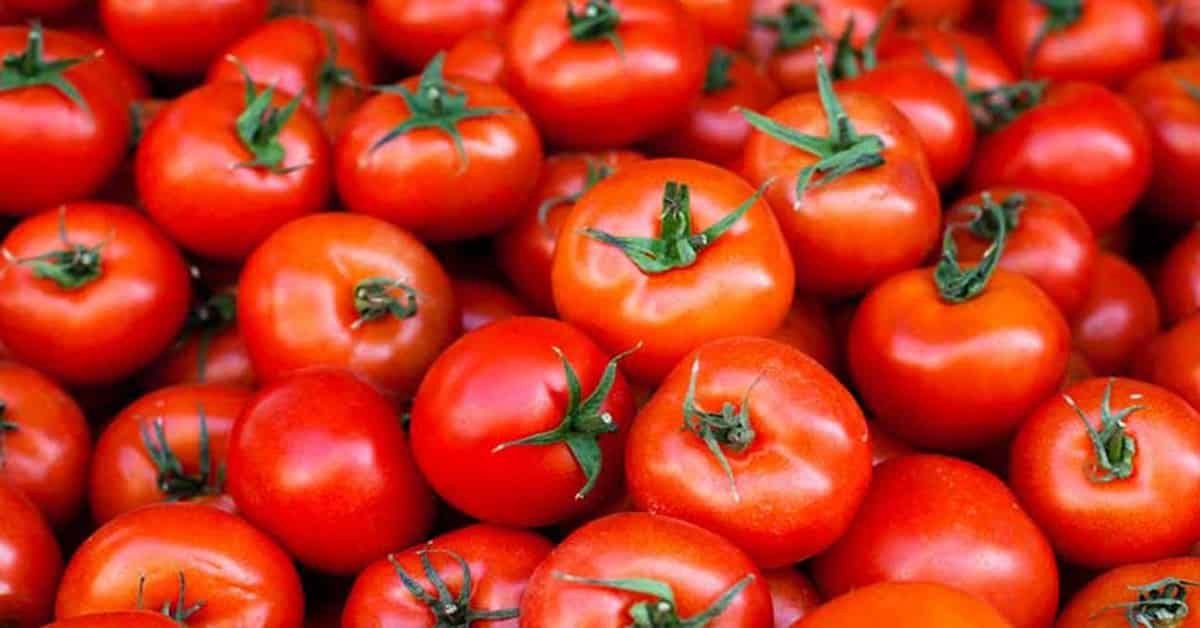About Tomatoes
Origin and History
- Scientific Name: Solanum lycopersicum
- Family: Nightshade (Solanaceae)
- Native Region: Tomatoes are believed to be native to western South America, particularly modern-day Peru and Ecuador. They were domesticated in Mexico and gradually spread around the world through Spanish and Portuguese explorers in the 16th century.
Varieties of Tomatoes
Tomatoes come in many varieties, each with unique flavors, textures, and uses. Some popular types include:
- Roma Tomatoes: Thick, meaty flesh ideal for sauces and canning.
- Cherry Tomatoes: Small, sweet tomatoes perfect for salads and snacking.
- Beefsteak Tomatoes: Large, juicy tomatoes often used for sandwiches and burgers.
- Heirloom Tomatoes: Varieties that have been cultivated over generations, known for their rich flavors and diverse colors.
- Grape Tomatoes: Similar to cherry tomatoes but oval-shaped, often used in salads and snacking.
Nutritional Value of Tomatoes
Tomatoes are nutrient-rich fruits that are widely used in various culinary dishes worldwide. They are low in calories but high in vitamins, minerals, and beneficial compounds. Here’s a breakdown of the nutritional content:
Nutritional Information (Per 100 grams of Raw Tomato)
- Calories: 18
- Water: 95%
- Protein: 0.9 g
- Total Fat: 0.2 g
- Saturated Fat: 0.0 g
- Monounsaturated Fat: 0.1 g
- Carbohydrates: 3.9 g
- Dietary Fiber: 1.2 g
- Sugars: 2.6 g
- Vitamins:
- Vitamin C: 13.7 mg (23% of the Daily Value)
- Vitamin K1 (Phylloquinone): 7.9 µg (9% of the Daily Value)
- Vitamin A: 833 IU (17% of the Daily Value)
- Vitamin E: 0.54 mg (3% of the Daily Value)
- Folate (Vitamin B9): 15 µg (4% of the Daily Value)
- Minerals:
- Potassium: 237 mg (5% of the Daily Value)
- Magnesium: 11 mg (3% of the Daily Value)
- Phosphorus: 24 mg (3% of the Daily Value)
- Calcium: 18 mg (1% of the Daily Value)
- Antioxidants:
- Lycopene: A powerful antioxidant that gives tomatoes their red color.
- Beta-Carotene: An antioxidant that the body converts to vitamin A.
Health Benefits of Tomatoes
Tomatoes offer numerous health benefits due to their rich nutrient profile and antioxidant content. Here are some of the key benefits:
1. Rich in Antioxidants
Tomatoes are packed with antioxidants, particularly lycopene, which is known for its ability to neutralize harmful free radicals in the body. This can help reduce oxidative stress and lower the risk of chronic diseases.
2. Supports Heart Health
The consumption of tomatoes has been linked to improved heart health. The antioxidants, fiber, and potassium found in tomatoes can help reduce the risk of heart disease by improving cholesterol levels, lowering blood pressure, and promoting healthy blood vessels.
3. Cancer Prevention
Lycopene has been studied for its potential role in reducing the risk of certain types of cancer, particularly prostate cancer. Research suggests that diets rich in tomato products may be associated with a lower risk of some cancers.
4. Improves Skin Health
Tomatoes contain several vitamins and antioxidants that promote skin health. Vitamin C is essential for collagen production, which helps maintain skin elasticity. Lycopene’s UV protection properties can also help prevent sunburn and skin damage.
5. Enhances Bone Health
Tomatoes are a good source of vitamin K, which is essential for bone health. Vitamin K helps in calcium absorption and bone mineralization. The potassium in tomatoes also plays a role in maintaining bone density.
6. Supports Digestive Health
Tomatoes are a good source of dietary fiber, which is important for digestive health. Fiber aids in regular bowel movements, prevents constipation, and promotes a healthy gut microbiome.
7. Aids in Eye Health
Tomatoes are rich in beta-carotene, lutein, and zeaxanthin, which are beneficial for eye health. These antioxidants help protect against age-related macular degeneration and cataracts, contributing to overall eye health.
8. Regulates Blood Sugar Levels
Some studies suggest that tomatoes may help in managing blood sugar levels and improving insulin sensitivity. Their low glycemic index and fiber content make them a suitable food for individuals with diabetes.
9. Improves Hydration
Composed of about 95% water, tomatoes can contribute significantly to hydration, making them a great addition to a hydration-focused diet, especially during hot weather or after exercise.
10. Weight Management
Tomatoes are low in calories and high in water content, making them an excellent food for weight management. They can add volume to meals without adding excessive calories, helping to promote a feeling of fullness.
Culinary Uses
Tomatoes are incredibly versatile and can be consumed in many forms, including:
- Fresh: In salads, salsas, or as snacks.
- Cooked: In sauces, soups, and stews, where cooking may enhance the bioavailability of some nutrients like lycopene.
- Sun-dried: As a concentrated flavoring for salads, pastas, and other dishes.
- Juiced: As tomato juice or as an ingredient in mixed beverages.
Tips for Selecting and Storing
- Selecting: Choose tomatoes that are firm, smooth, and slightly fragrant. Color should be vibrant and uniform.
- Storing: Store ripe tomatoes at room temperature, away from direct sunlight. Refrigeration can alter their texture and flavor, so it’s best to store unripe tomatoes until they ripen, then consume them shortly after.
FAQs about Tomatoes
Here are some frequently asked questions (FAQs) about tomatoes, including their nutrition, health benefits, culinary uses, and more.
1. What is a tomato?
Tomatoes are the edible fruit of the plant Solanum lycopersicum, belonging to the nightshade family. They are commonly used in various cuisines worldwide and are available in many varieties.
2. Are tomatoes fruits or vegetables?
Botanically, tomatoes are classified as fruits because they develop from the flower’s ovary and contain seeds. However, in cooking, they are often used as vegetables due to their savory flavor.
3. What are the health benefits of tomatoes?
Tomatoes provide numerous health benefits, including:
- Rich in antioxidants, particularly lycopene, which may reduce the risk of certain cancers.
- Support heart health by improving cholesterol levels and lowering blood pressure.
- Promote skin health due to high vitamin C content.
- Aid in digestion as a good source of dietary fiber.
- Help maintain eye health with nutrients like lutein and zeaxanthin.
4. How many calories are in a tomato?
A medium-sized raw tomato (about 123 grams) contains approximately 22 calories. Tomatoes are low in calories, making them a great addition to a healthy diet.
5. Are tomatoes good for weight loss?
Yes, tomatoes can be beneficial for weight loss. They are low in calories, high in water content, and rich in fiber, which helps promote fullness and reduces overall caloric intake.
6. Can eating tomatoes help prevent cancer?
Research suggests that the lycopene in tomatoes may have cancer-fighting properties, particularly in reducing the risk of prostate cancer. A diet rich in tomatoes and tomato products has been associated with a lower risk of certain cancers.
7. How should tomatoes be stored?
Ripe tomatoes should be stored at room temperature, away from direct sunlight. For unripe tomatoes, keep them in a cool place until they ripen. Refrigeration can alter the texture and flavor of ripe tomatoes, so it is generally not recommended.
8. What are the different varieties of tomatoes?
There are many varieties of tomatoes, including:
- Roma Tomatoes: Meaty and ideal for sauces.
- Cherry Tomatoes: Small, sweet, and perfect for salads.
- Beefsteak Tomatoes: Large and juicy, often used in sandwiches.
- Heirloom Tomatoes: Traditional varieties known for their rich flavors and colors.
9. Can you eat tomato skin?
Yes, tomato skins are edible and nutritious. They contribute dietary fiber and contain antioxidants like flavonoids and carotenoids. Some people prefer to peel tomatoes for certain recipes, but leaving the skin on maximizes nutritional benefits.
10. Are cooked tomatoes more nutritious than raw tomatoes?
Cooking tomatoes can enhance the bioavailability of certain nutrients, particularly lycopene, making it easier for the body to absorb. While both raw and cooked tomatoes have health benefits, incorporating both forms into your diet can provide a wider range of nutrients.
11. Are tomatoes high in sodium?
Fresh tomatoes are low in sodium. However, processed tomato products (like canned tomatoes and sauces) may contain added salt, so it’s important to check labels if you’re monitoring sodium intake.
12. Can tomatoes cause allergies?
While tomato allergies are rare, some individuals may experience allergic reactions to tomatoes, which can include symptoms like itching, rash, or gastrointestinal discomfort. If you suspect an allergy, consult with a healthcare professional.
Conclusion
Tomatoes are a powerhouse of nutrition, offering a myriad of health benefits and culinary versatility. Whether enjoyed raw, cooked, or in sauces, incorporating tomatoes into your diet can contribute significantly to overall health and well-being. For optimal health benefits, consider consuming a variety of tomato types, including cherry tomatoes, beefsteak, and heirloom varieties, to enjoy different flavors and nutrients.


